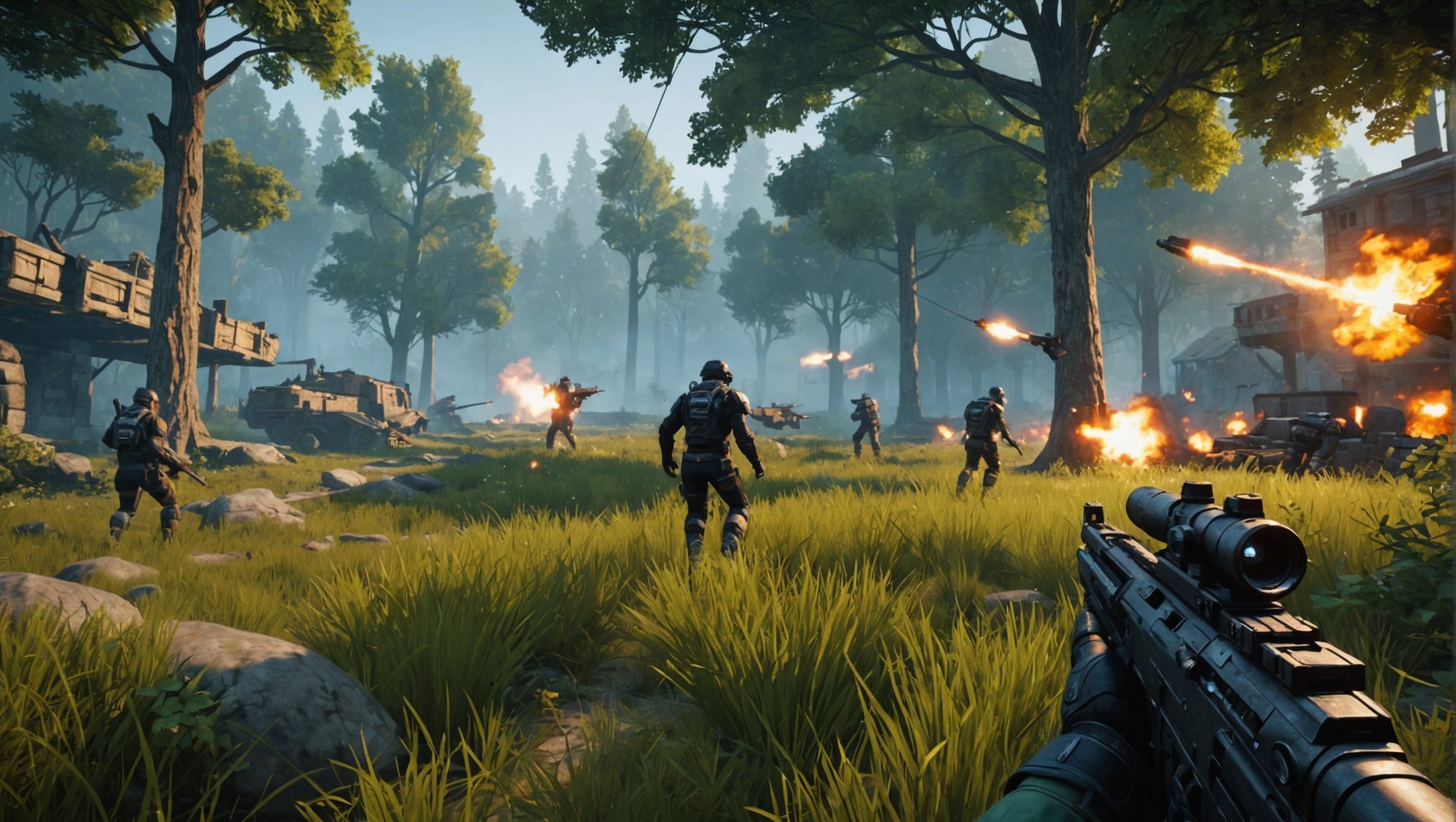AI Applications in Multiplayer Survival Games
AI technology has profoundly transformed the landscape of multiplayer survival games, offering both challenges and enhanced experiences. AI technology in gaming primarily aims to create more immersive worlds, where environments and NPCs (non-player characters) react dynamically to player actions. This adaptability fosters a sense of realism and unpredictability, crucial for sustaining player interest and engagement.
In multiplayer settings, player engagement is paramount. Games leverage AI to maintain the fluidity of interactions, often adjusting the difficulty level to match player skill, thereby ensuring a balanced and enjoyable experience for everyone. As players are confronted with AI-driven challenges tailored to their abilities, competitive spirit and cooperation are naturally encouraged.
Also to see : Unlocking Fear: Leveraging Adaptive Audio Techniques to Deepen Player Immersion in Horror Games
Current trends reveal that AI is being utilised to personalise gameplay. Through sophisticated algorithms, AI technology can analyse player behaviour patterns and adjust the game in real-time, offering custom scenarios and missions. This level of personalisation not only holds players’ attention but also creates a unique narrative journey, making each game session feel engaged and fresh.
Overall, multiplayer survival games thrive on the innovative use of AI, ensuring these virtual worlds remain captivating and versatile playgrounds for players worldwide.
Also to see : Unlocking AI”s Potential: Crafting Personalized In-Game Tutorials for New Players
Personalized Player Experiences
Creating personalized experiences in games involves understanding player preferences through adaptive AI and leveraging this information to tailor game mechanics. Adaptive AI can ensure that each player’s interaction with the game feels unique and engaging.
Utilizing Player Data
Player data is pivotal in customizing game experiences. Data such as play style, previous interactions, and choices are used to understand what players enjoy. Adaptive AI systems analyse this information, enabling games to feel personalised. These insights can be garnered from in-game behaviour and real-time analytics, giving developers the tools to enhance player satisfaction.
Tailoring Game Mechanics
Tailoring game mechanics involves adjusting the game environment and challenges based on the individual’s preferences. With adaptive AI, games can dynamically alter difficulty levels, story arcs, and even character interactions. This ensures that players remain engaged and find the game both challenging and rewarding, offering just the right amount of difficulty and intrigue.
Implementing Feedback Loops
Feedback loops are essential for refining adaptive systems. By continuously collecting player feedback, developers can adjust and improve game elements to better align with player desires. Examples include adjusting scenarios based on prior experiences and introducing new challenges. Such loops ensure the game evolves with the player’s preferences, sustaining long-term interest and enjoyment.
Adaptive Difficulty Systems
In the realm of video games, adaptive difficulty is a critical component that tailors gameplay to individual player skill levels. This dynamic approach ensures players remain engaged by providing just the right amount of challenge, neither too easy nor overwhelmingly difficult. The core of adaptive difficulty lies in the use of AI algorithms which meticulously assess player performance in real-time.
These algorithms monitor various gameplay elements, such as completion time, error rates, and decision-making processes. With this data, the game can dynamically adjust to create dynamic challenges that maintain a balance between challenge and enjoyment. For instance, if a player consistently dispatches enemies with ease, the game might introduce more formidable adversaries or increase their numbers to keep the experience engaging.
The importance of adaptive difficulty cannot be overstated, particularly when it comes to player retention. By ensuring that players are consistently tested within their skill range, games can foster long-term interest and satisfaction. This intelligent balancing act, via adaptive systems, is pivotal in steering players towards continued interaction with the game, and preventing frustration from potential skill level mismatches. Consequently, adaptive difficulty stands as a cornerstone in modern game design, prioritising player satisfaction and sustained engagement.
NPC Behavior Enhancements
In multiplayer survival games, NPC behavior is crucial to creating a dynamic and immersive experience. These non-player characters (NPCs) are not just parts of the environment but significant elements that enrich gameplay. By employing AI-driven interactions, developers can imbue NPCs with realistic, responsive behaviors that react to player actions, enhancing the overall immersion.
Successful case studies highlight how augmented AI can transform player engagement. For example, in certain top-tier games, NPCs exhibit adaptive learning—altering tactics based on players’ choices—which not only keeps the players on their toes but also contributes to a more lifelike gaming environment. Achieving such realism requires sophisticated programming, where NPCs can interpret player behavior and respond aptly, often adding unpredictable yet authentic reactions to common scenarios.
Moreover, these AI advancements contribute to increased player immersion by making games feel more alive. When NPCs change the course of action based on player decisions and external stimuli, they create a richer narrative and a more complex environment. This encourages players to explore and interact with the game world, knowing their actions may lead to unique outcomes shaped by nuanced NPC behavior.
Procedural Content Generation
Delving into procedural generation, it’s apparent that this technique is revolutionising the way game worlds are crafted. With AI-generated environments, developers can create expansive and complex landscapes without manually designing each element. This not only enhances game diversity but also enables games to offer new experiences every time they are played.
Creating Unique Game Worlds
Procedural generation allows for the creation of unique game worlds by algorithmically producing content that differs with each playthrough. This method can include generating terrain, vegetation, and other environmental features. By doing so, developers can ensure that no two games are exactly alike, enriching the player’s experience through unpredictability.
Dynamic Quest Systems
Incorporating AI-generated environments extends to quest generation as well. AI techniques allow for dynamic quest systems where narratives can evolve based on player decisions, maintaining players’ interests through variety and adaptability. This approach ensures that quests are never identical and add a layer of freshness each time they are undertaken.
Player-driven Content
By utilising AI, players can be more actively involved in content creation. AI tools can empower players to partake in their own unique storylines and objectives, enhancing their engagement and investment in the game. This not only improves replayability but also allows for an ever-evolving in-game universe.
Case Studies of Successful AI Implementation
Successful case studies of AI technology in game development provide a fascinating view of its capacity to enhance gaming experiences. Notable multiplayer survival games utilise AI to achieve enhanced player interaction and engagement. Take, for instance, the analysis of titles like “Fortnite” and “Rust,” where AI is central in evaluating player feedback and refining in-game dynamics.
AI techniques often involve rigorous game analytics to understand player behaviour deeply, enabling personalised game experiences. These analytics aid in adapting gameplay to suit diverse player preferences, ensuring a higher level of satisfaction and ongoing engagement.
The effectiveness of AI in these scenarios is often measured through metrics such as increased playtime, improved levels of player retention, and overall satisfaction. Such metrics indicate how well games can hold player attention, directly correlating with the engagement level.
Valuable lessons learned from these implementations include the significance of regularly updating AI algorithms to reflect real-time player feedback and the importance of best practices involving continuous data collection and analysis for ongoing improvement. Embracing these practices enables game developers to create more captivating and responsive gaming worlds.
Future Developments in AI for Multiplayer Games
The future trends in AI for multiplayer games are set to revolutionise player experiences and game mechanics. AI advancements will increasingly incorporate emerging technologies, offering seamless integration with machine learning. These technologies promise to create more dynamic and responsive gaming environments.
Emerging Technologies
In the realm of multiplayer games, emerging technologies such as augmented reality (AR) and virtual reality (VR) are beginning to blur the lines between the virtual and the real world. These technologies are key to enhancing player immersion, providing innovative ways for players to interact both with the game and each other.
Integration of Machine Learning
Machine learning stands at the forefront of game innovation, offering tools to enhance player interaction. By analysing player behavior, machine learning algorithms can adapt in real-time, creating more personalised and challenging experiences. This integration is expected to elevate gameplay, making future games more engaging and rewarding.
Vision for the Next Generation of Games
Predictions about AI’s evolution in gaming suggest that player communities will experience an unprecedented level of customisation and challenge. Machine learning and AI advancements are anticipated to drive innovation, transforming the industry by making games more intuitive and responsive. As these features become commonplace, they will undoubtedly shape the future landscape of multiplayer gaming.











